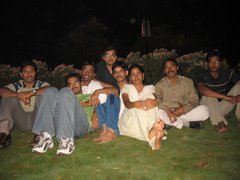The HAL Tejas (Sanskrit: तेजस् : "Radiance") is an advanced, lightweight, supersonic multirole fighter aircraft being developed by India. It is a tailless,[1] c ompound delta wing design powered by a single engine. The project was originally known as the Light Combat Aircraft (LCA) – a designation which continues in popular usage – but was officially christened "Tejas"[2] by then former Prime Minister Atal Bihari Vajpayee in a ceremony held on 4 May 2003.[3]Limited series production of the Tejas commenced in 2007; it is currently projected to achieve limited initial operational clearance (IOC) with the Indian Air Force (IAF) by 2008, followed by full operational clearance (FOC) by the end of 2010.[4] A two-seat trainer variant is also in development, as is a naval variant capable of operating from the Indian Navy's aircraft carriers.
ompound delta wing design powered by a single engine. The project was originally known as the Light Combat Aircraft (LCA) – a designation which continues in popular usage – but was officially christened "Tejas"[2] by then former Prime Minister Atal Bihari Vajpayee in a ceremony held on 4 May 2003.[3]Limited series production of the Tejas commenced in 2007; it is currently projected to achieve limited initial operational clearance (IOC) with the Indian Air Force (IAF) by 2008, followed by full operational clearance (FOC) by the end of 2010.[4] A two-seat trainer variant is also in development, as is a naval variant capable of operating from the Indian Navy's aircraft carriers.
The Indian Light Combat Aircraft (LCA -- sometimes called Last Chance Aircraft) is the world's smallest, light weight, multi-role combat aircraft. The LCA is designed to meet the requirements  of Indian Air Force as its frontline multi-mission single-seat tactical aircraft to replace the MiG-21 series of aircraft. The delta wing configuration, with no tailplanes or foreplanes, features a single vertical fin. The LCA is constructed of aluminium-lithium alloys, carbon-fibre composites, and titanium. LCA integrates modern design concepts and the state-of-art technologies such as relaxed static stability, flyby-wire Flight Control System, Advanced Digital Cockpit, Multi-Mode Radar, Integrated Digital Avionics System, Advanced Composite Material Structures and a Flat Rated Engine.
of Indian Air Force as its frontline multi-mission single-seat tactical aircraft to replace the MiG-21 series of aircraft. The delta wing configuration, with no tailplanes or foreplanes, features a single vertical fin. The LCA is constructed of aluminium-lithium alloys, carbon-fibre composites, and titanium. LCA integrates modern design concepts and the state-of-art technologies such as relaxed static stability, flyby-wire Flight Control System, Advanced Digital Cockpit, Multi-Mode Radar, Integrated Digital Avionics System, Advanced Composite Material Structures and a Flat Rated Engine.
Within India’s force structure, the LCA is largely expected to replace its 400 or so MiG-21 aircraft with a more versatile and capable performer who can outlast the 125 or so upgraded MiG-21 ‘Bisons’ scheduled to remain in service until 2016. Performance is expected to be somewhat similar to a Mirage 2000 (which India flies) in terms of weapons, size, et. al., with lesser top speed but interior electronics that are fully up to date. Its price point is unknown at present, but the goal of an inexpensive fighter with performance that compares well to earlier model F-16s and Mirage 2000s could make this aircraft a capable export contender around the Third World.
The Kaveri Engine: Keystone, or Killer?
One of the issues facing the program, however, is the fallout from India’s drive to develop an indigenous “Kaveri” jet engine. As the Rediff’s February 5, 2006 report notes:
“DRDO scientists had kept the development of the Kaveri engine under wraps, exuding confidence that India had developed the technological edge to develop its own aircraft engine, so far confined to handful of developed countries.” 
Some of the reasons for that are technical. Modern jet engines are far more complex than even Vietnam-era engines like the GE 79 that equipped the F-4 Phantom. Producing a working, reliable engine that can operate at these high pressures and thrust ratings is not easy. In addition, the Kaveri engine’s requirements are being specifically designed for Indian environment. The engine is a variable cycle-flat-rated engine in which the thrust drop due to high ambient, forward speed is well compensated by the increased turbine entry temperature at the spool. This concept has been already demonstrated under high temperature and pressure conditions in DRDO’s High Mach Facility. The engine is controlled by a Kaveri full authority digital control unit {KADECU), which DRDO claims to have developed and successfully demonstrated at its test bed.




No comments:
Post a Comment